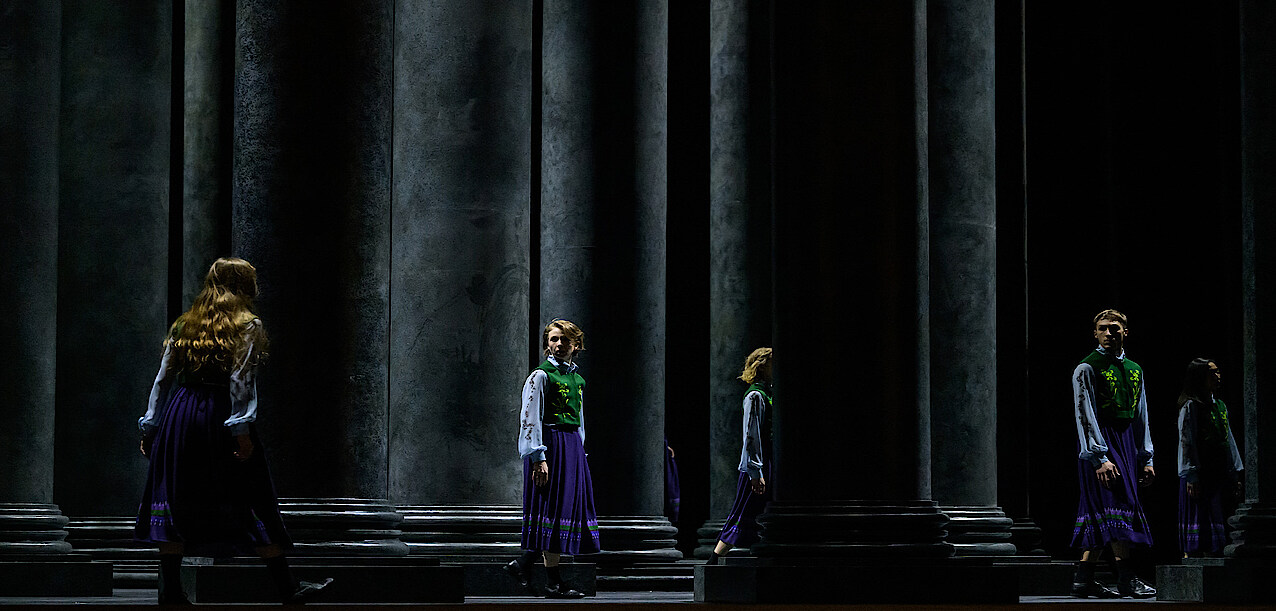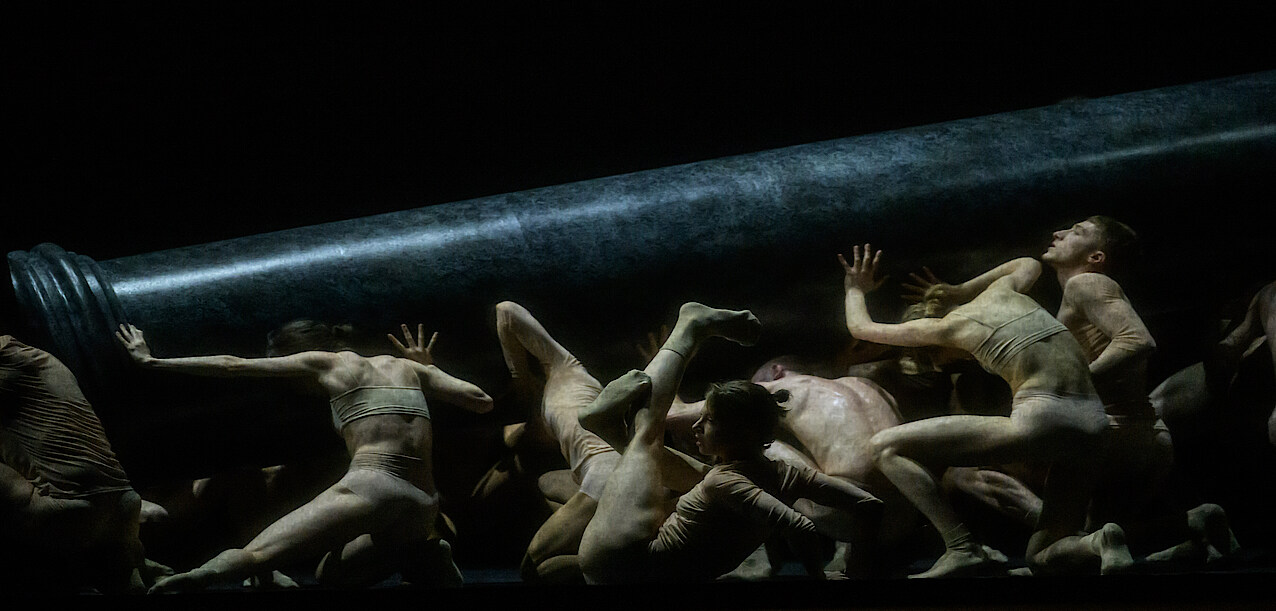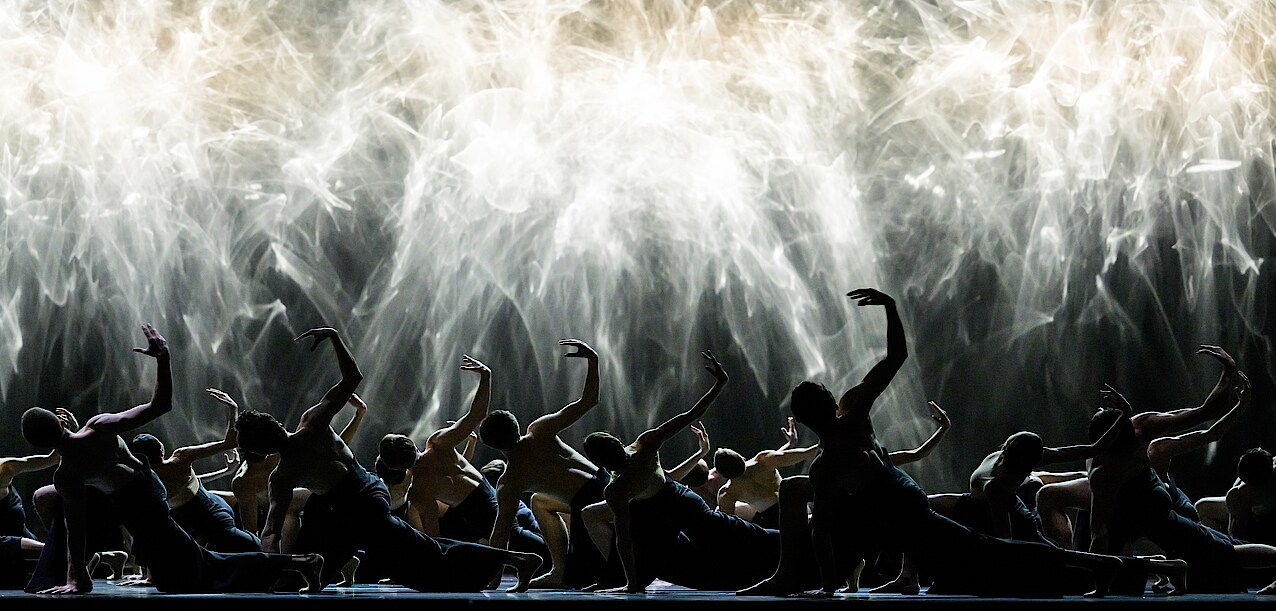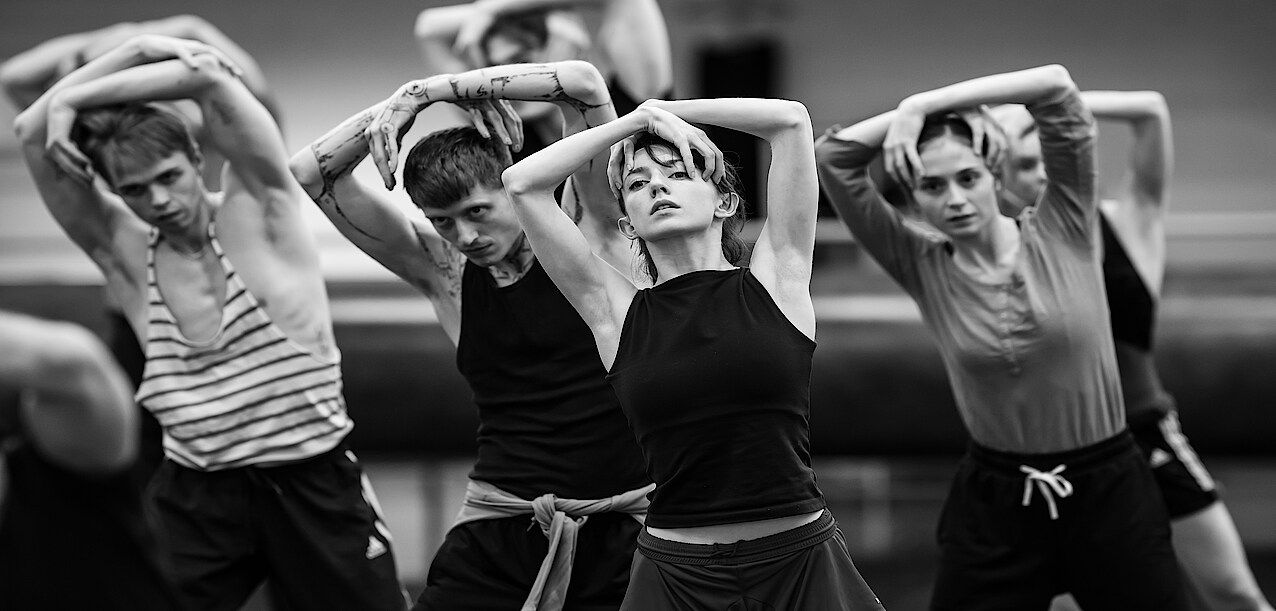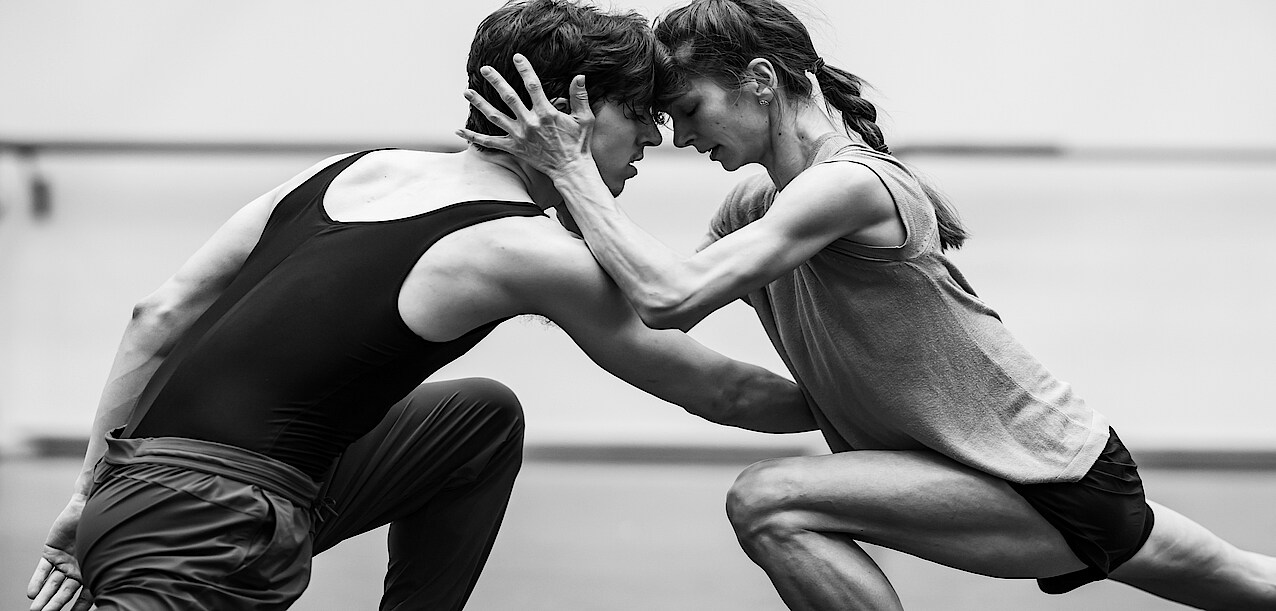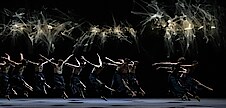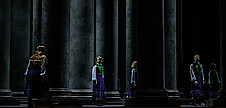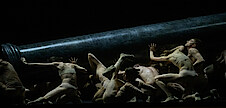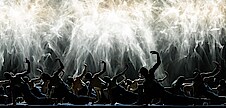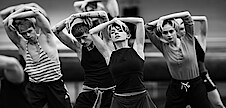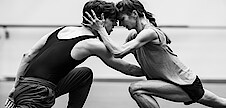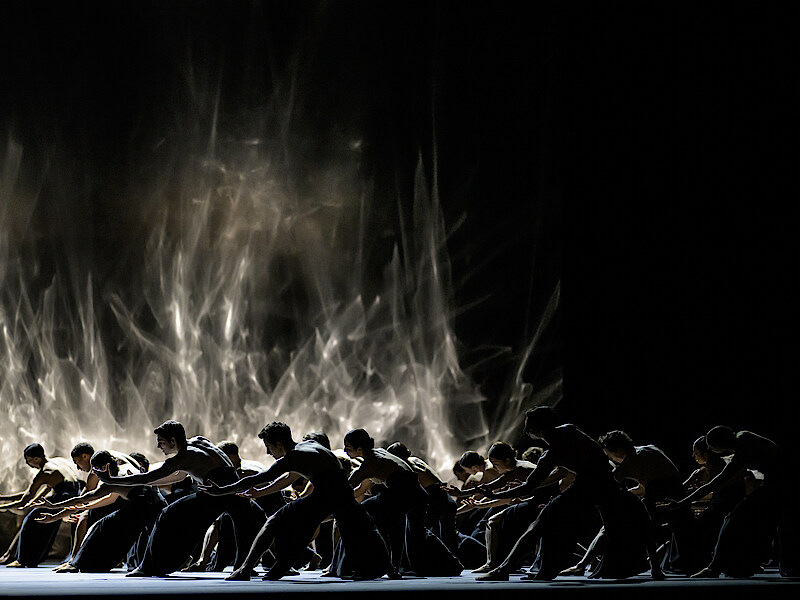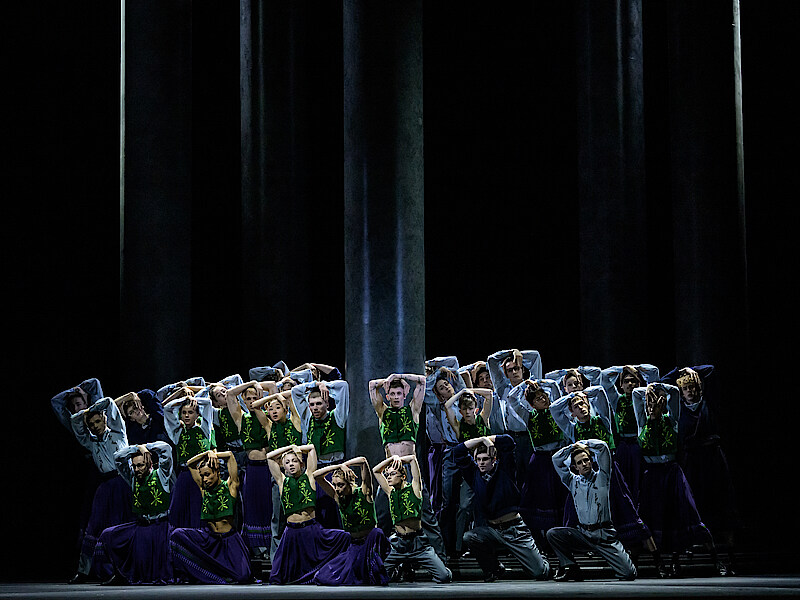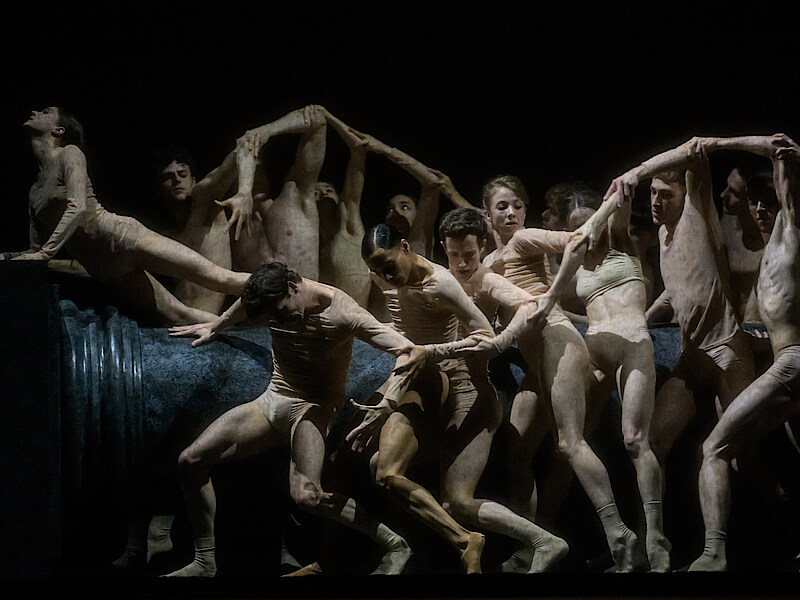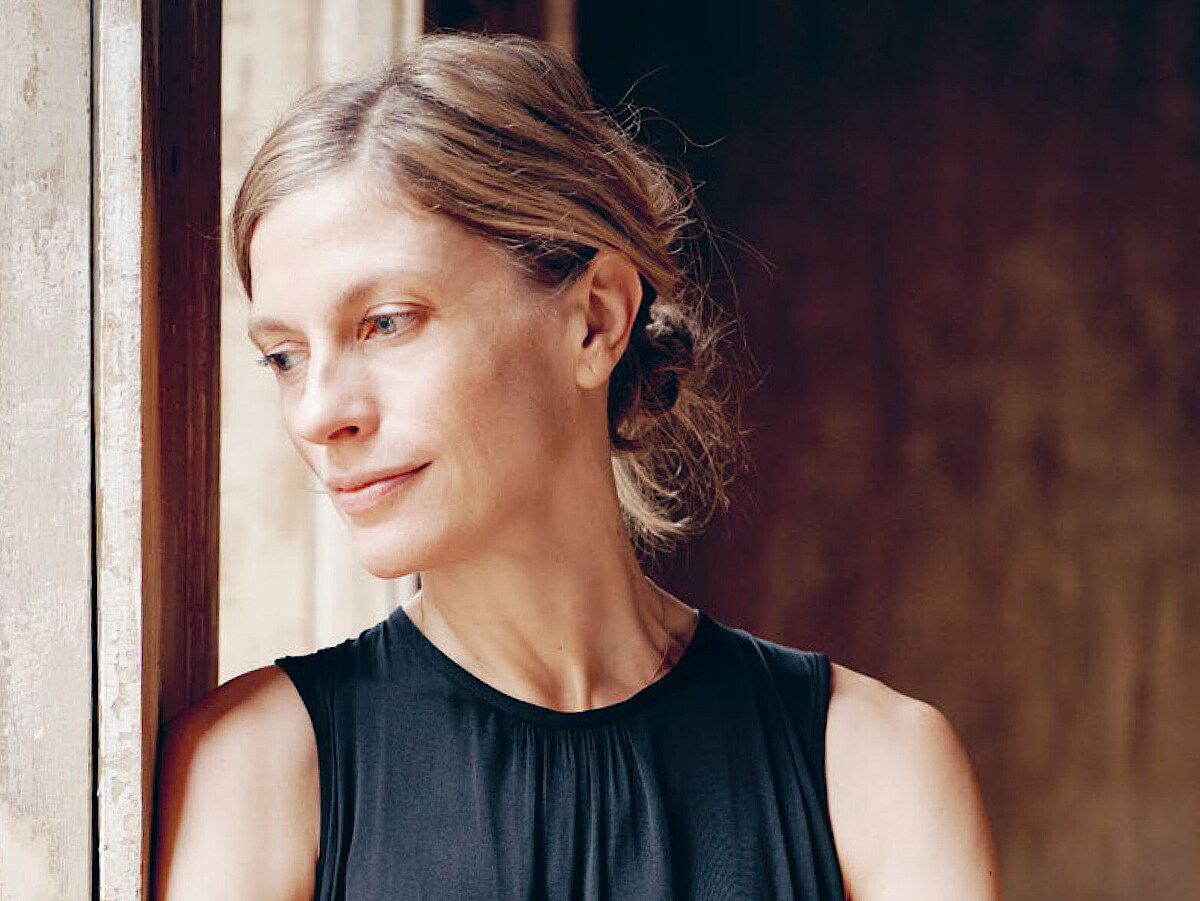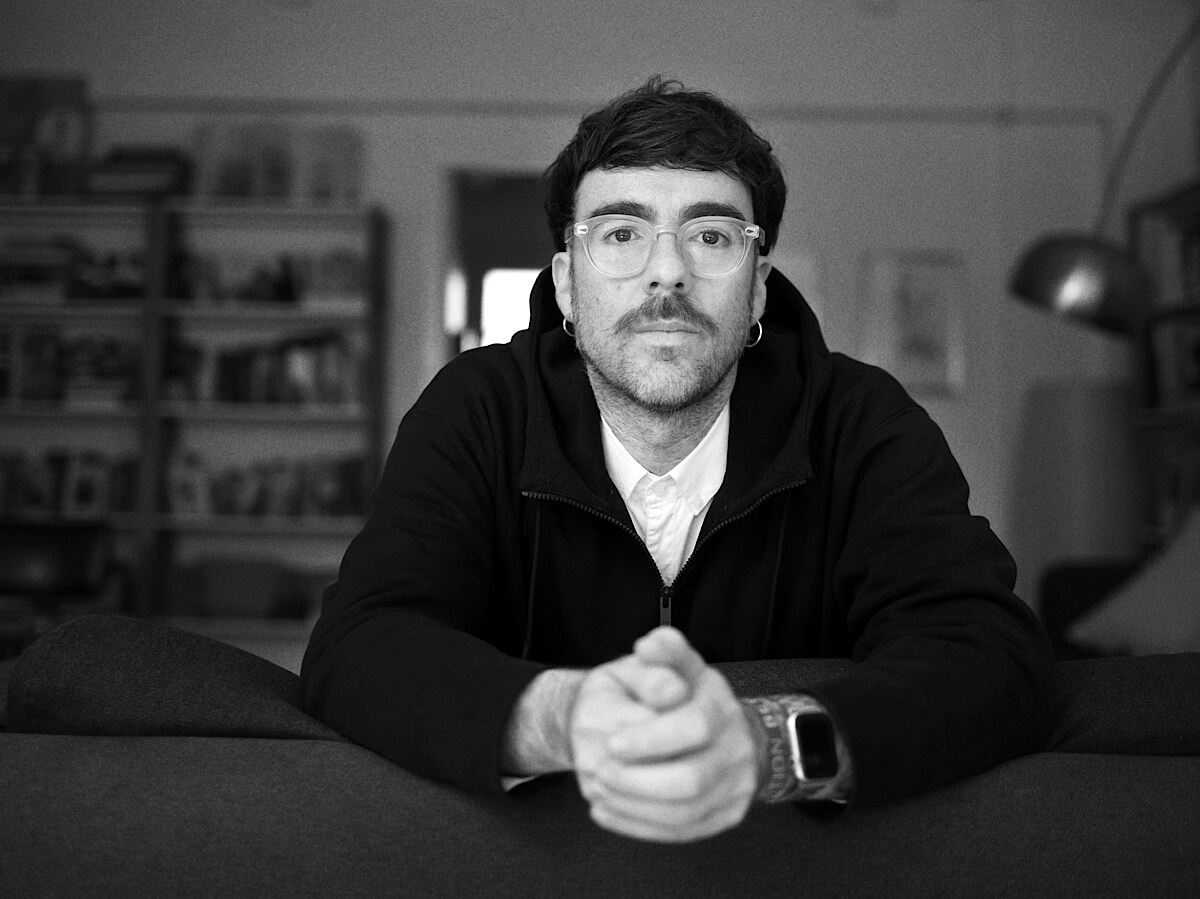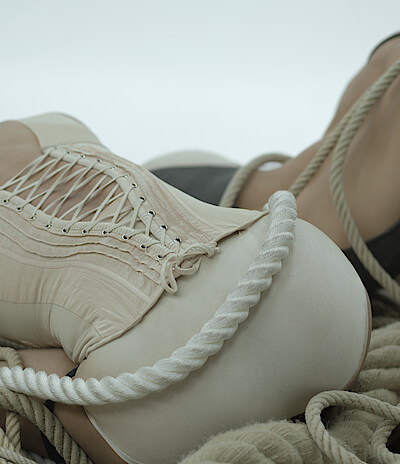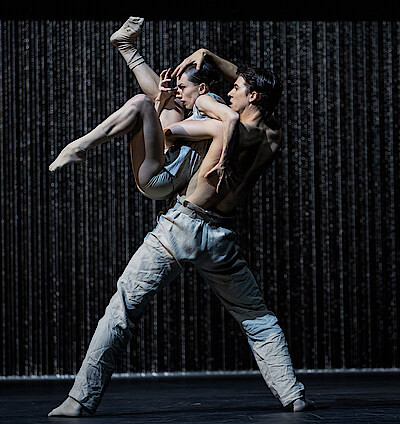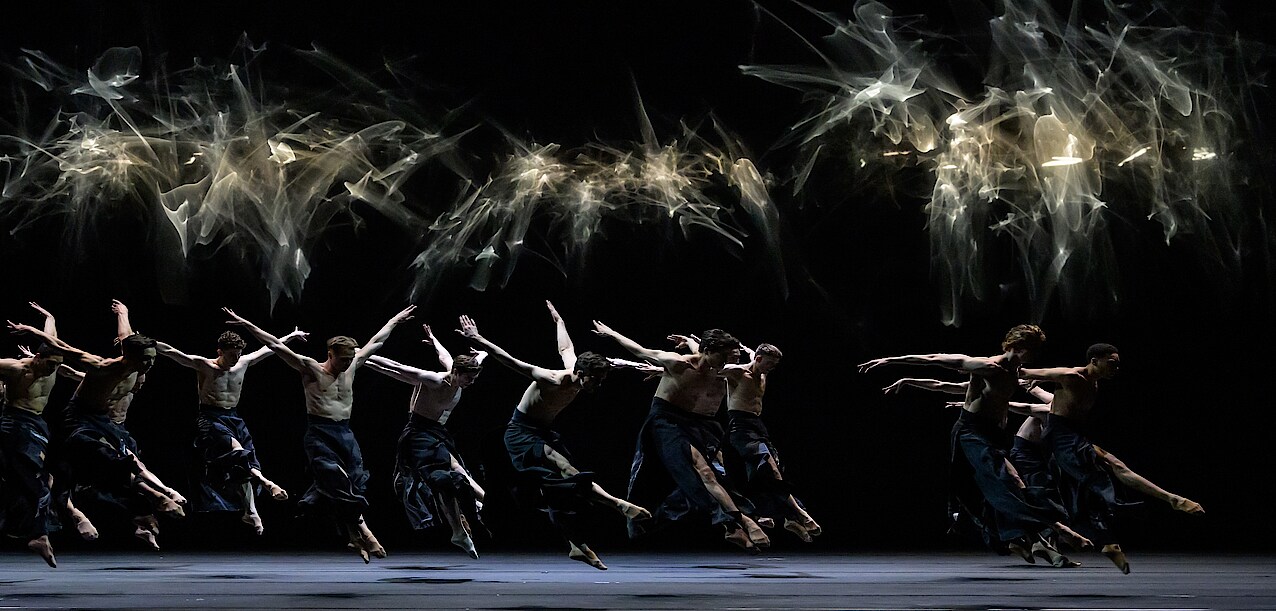
No further performances this season.
«I like working in a form that is always in a state of disappearing.»
Choreographer Crystal Pite in conversation
Staatsballett Berlin (SBB) How did your creation Angels’ Atlas come about? What role did the stage and the lighting design play?
Crystal Pite (CP) The impetus for the creation of Angels’ Atlas came from my partner and set designer Jay Gower Taylor. Through our last few creations, Jay has been developing a system that allows him to manipulate reflected light. Working with lighting designer Tom Visser, they've been discovering myriad ways to deliver light to a surface.
SBB Can you tell us more about the system developed by Jay that works with reflected light? How does this technique influence your artistic creation?
CP The system is analog, made of the simplest materials, yet it manifests complex, painterly images that have the illusion of depth and a sense of the natural world. There is a quality of controlled chaos about it. The light dances on a pivoting, reflective topography, creating the conditions for the unexpected to appear. For us, this wall of morphing, shifting light is a frontier, a portal, a portrait of the unknown.
SBB That sounds very philosophical. Where did the inspiration come from?
CP When I was a little kid, my uncle and my dad talked to me a lot about the cosmos. Sometimes I would experience a dizzying thrill in brief moments of embodied comprehension: it felt like I was falling within the vastness of it all. They inspired me to wonder about colossal ideas that were, and always will be, beyond my grasp and to approach great unanswerable questions with imagination and creativity.
SBB And light is a perfect medium for that?
CP Working with light in this way reminds me of that feeling of wonder and my longing to lean into the unknowable. The light looks intelligent, awesome. The chaos and beauty of it make me feel small in a thrilling, destabilized way. Small, in the face of unanswerable questions about things like love, death and the infinite.
SBB Dance is often described as an ephemeral art form. How do you see parallels between the movement of light and the art form of dance?
CP The movement of the light is mercurial and ephemeral in the same way that choreography is. It reminds me of something the writer and critic Max Wyman said about dance: «It is an artform that simultaneously defines and defies the ephemerality of existence. We have nothing but the body, and soon enough we will not even have the body. But it is that physicality that speaks so eloquently about the implications of mortality and at the same time voices our defiance. No other artform speaks so directly about the fragile, temporary quality of life, or about the human instinct to transcend those bonds and aim for that perfect moment of self-realization. »
SBB The quote sounds wonderful. How does this concept of transience integrate into your artistic work? What do you aim to evoke and achieve with the choreography?
CP I like to think of the body as a location, a place where being is held and shaped. In this way, dance gives form to the unknown. In the dancing body, the unknown appears as something both familiar and extraordinary. We might possibly catch a glimpse of something eternal. But both the dancers and the dance are temporary: their beauty resonates with meaning because of their impermanence. This is potent for me. I like working in a form that is always in a state of disappearing.
SBB How do you manage to create meaning beyond transience in an art form that constantly disappears?
CP I am trying to create something that speaks of our impermanence and ‘voices our defiance’ as Wyman says. Something that evokes a fierce pulse of life. The ephemeral part will take care of itself.
Quoted from the Ballet Paper No. 2, the interview was conducted by Katja Wiegand.
The Wake-Up Caller and Agitator
Portrait of choreographer Marcos Morau
The Spanish choreographer Marcos Morau has been the «Artist in Residence» at the Staatsballett Berlin since this season. Until 2026, the internationally celebrated artist will create three choreographies with the ensemble. The beginning of this collaboration is marked by Overture with music by Gustav Mahler, and its premiere will be part of the two-part ballet evening on April 28th at the Staatsoper Unter den Linden.
There are few choreographers of the younger generation who have had a similarly meteoric career trajectory: Marcos Morau, who himself was never trained as a dancer, has caused a veritable hype in the dance world. Audiences and critics alike rave about the strong photographic intensity of his images, the fascinating body cascades, and frescoes he creates. It's said that his vocabulary, quick, delicate, and witty, equips his expressionistic tableaus.
Morau is the recipient of the Sebastián Gasch Award, a prestigious prize from the «FAD – Foundation for Arts and Design», and has won numerous awards at international choreography competitions. In 2013, his creations earned him the Spanish National Dance Prize and an invitation to the Venice Biennale. He has choreographed for renowned companies in Rotterdam, Gothenburg, Copenhagen, Lyon, and Zurich. With his troupe La Veronal, he has performed worldwide, including in Paris, Amsterdam, Berlin, Rome, Seoul, and London.
When the magazine tanz named Marcos Morau the «Choreographer of the Year» in 2023, the laudator Bettina Trouwborst wrote, «Marcos Morau is a wake-up call. His surreal, animated tableaus grotesquely accentuate historical as well as current societal crises. From monstrosity and beauty, as the 40-year-old puts it, he composes an aesthetic that can be downright alarming in its unsparingness. It is shaped from dance, music, visual arts, literature, film, and photography.» Dance at the intersection of film and theater: The way Morau boldly combines all these elements in his universe makes his creations so extraordinary. The Berlin audience has long embraced Marcos Morau and his Gesamtkunstwerk. La Veronal has performed four times at the «Tanz im August» festival, each time with sensational success. Siena (2014), Voronia (2015), Pasionaria (2018), and Sonoma (2022) – different pieces, but always marked by Morau's distinctive signature. Virve Sutinen, the former curator of the festival, was always eager to be surprised by his visually rich creations: «He creates amazing theatrical worlds full of cultural references, and there's often humor, which is very scary in dance. Many of his works have something eerie about them. There are phantasmagorical scenes, even magic, which connects him with surrealistic art and absurdism.»
According to Morau's own assessment, it's precisely the fact that he's not a trained dancer, but rather studied photography, theater science, and dramaturgy, that allows him to look at the stage freely and from different perspectives. «I believe everything is more interconnected nowadays than ever before. I am influenced by cinema, literature, photography, dance, opera – everything together. But I don't try to reproduce the world. Reality is not enough on stage. I want to create a new world, motivate and inspire people, because I suffer from this world too. That's why I like to create new universes, new landscapes. I use the stage for that. It's the place where I constantly explore my fears and desires about the world. I have many questions, and I don't try to find answers.»
Part of Morau's unique style of creating virtuoso dance involves a style that combines strict technique with lively movement. He calls the tool he developed to generate movement material «Kova». Through a strict set of rules of dance actions, Kova constantly creates obstacles and problems for the dancer's body. In this context, the dancer, constantly struggling to solve the challenges he has imposed on himself, can convey an appealing sense of freedom and great possibilities. The viewer finds themselves facing a complex and rich choreographic panorama, in a labyrinth of body language, free from themes and predefined recognizable forms within a figurative framework.
«Kova is a language for me, and it is constantly evolving. I take it everywhere, and it changes with me, adapting depending on the context. Now that I'm working with the ensemble of the Staatsballett, a wonderful mix of artists and young talents, they won't just learn my language. It's also a place of creation where it's accepted that anything can happen. Kova might be more like a costume they can wear. It's more about the rhythm for me, my approach to the themes, the characters, or reality.»
Marcos Morau now receives offers from renowned companies all over the world. «He is one of the most productive choreographers I know, always in motion, always creating new works,» says Virve Sutinen, who attributes his success to his years of hard work. In his working relationships, Morau seeks a quality that he doesn't find everywhere. «I have to say 'no' to many places, and I want to say 'yes' to the places where the people I trust are. You want to feel good, protected, and loved. You want to feel that you can build a long-term relationship. Today, everything, even relationships, is very fleeting and fluid. I find it beautiful to feel solid ground beneath my feet.»
At Ballet Zurich, where he created his spectacular production Nachtträume on invitation by Christian Spuck in 2022, Marcos Morau found what he was looking for – and the interest was mutual. Christian Spuck knew that he wanted to shape the program of his first season as the artistic director of the Staatsballett Berlin with this choreographer. When Morau suggested not only committing to one production but rather for several years, Spuck was enthusiastic. «I highly value Marcos and am an admirer of his work. I am very pleased that he will be working with the ensemble of the Staatsballett for three consecutive years as 'Artist in Residence'. This continuity is a great enrichment for everyone, for the dancers, for us as an institution, for the choreographer, and also for the works themselves.»
Overture is Morau's first creation with the Staatsballett Berlin, set to the iconic music from Gustav Mahler's 5th Symphony, interpreted by the Staatskapelle Berlin under the direction of Marius Stravinsky, and it places the theme of renewal at its center. «I am preoccupied with the question of how long a culture and society can survive without change. What happens when the new generation no longer initiates change?» The stage design conveys this idea in the form of ancient temple columns, which represent for him the beginning of civilization. «We build temples, then we destroy them, build and destroy civilizations and even ourselves... and then we begin to erect new columns again.» The costume design also references connections to tradition and folklore: «When you understand the past and are curious about what others before us have done, you understand the present. I find it beautiful to blend subtle folklore references with modernity. I want to mix the past and the present and leap into the future.»
Let us be surprised. Since Marcos Morau remains true to his style, which offers the audience unique experiences, one thing is certain: It will be a celebration for all the senses!
Quoted from the Ballet Paper No. 2, author: Maren Dey, interview Marcos Morau: Katja Wiegand
